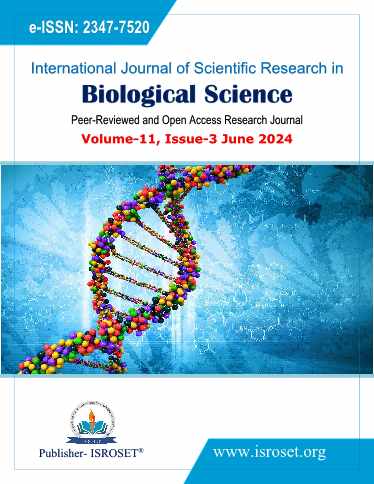Genetic Diversity of Pleurotus Ostreatus Using Random Amplification Polymorphisms DNA Technique
Keywords:
RAPD-PCR, dendrogram, P. ostreatusAbstract
— Mushrooms are the reproductive structures of large fungi that do not have leaves or tissues containing chlorophyll. Nevertheless, they continue to increase in size and generate fresh organic matter on an annual basis. Mushrooms provide high nutritional value and can be consumed as food, tonic, and medicinal substances. They include a high amount of crude fibre, proteins, and beneficial vitamins, while having a low content of fat and calories. They have many therapeutic benefits. The edible King Oyster mushroom (i.e. Pleurotus ostreatus) is part of the genus Pleurotus, which is regarded significant. Using various molecular techniques, genetic variation amongst several strains of wild macrofungi could be documented and expressed. This work examined the relatedness and genetic diversity of Pleurotus ostreatus from various locations. To determine the genetic diversity of P. ostreatus, a random amplified polymorphic DNA-polymerase chain reaction marker was used. 6 of the 21 bands produced by two primers (OPL-03 and OPI-05), which indicated variability between the isolates examined, were polymorphic and ranged in size from 250 to 1 kb. The phylogenetic analysis for two primers used in this study led to classification into three clusters, the first includes PO1 and the second cluster includes PO8 and the third major cluster contained 3 classes (first class includes PO7 second class PO9 and third class contains PO3, PO4, PO2, PO5and PO6. Conclusions Genetic diversity and genetic relatedness of the examined wild P. ostreatus were revealed by RAPD. This will enhance the selection of strains for additional utilizations and documentations.
References
Nuha. Alam et al., “Vegetative growth and phylogenetic relationship of commercially cultivated strains ofpleurotus eryngiibased on its sequence and RAPD,” Mycobiology, Vol.37, Issue.4, p.258, 2009.
“Medicinal value,” Mushrooms, pp.39–51, 2004. doi:10.1201/9780203492086.ch3
Rgarai. Casalvara et al., “Biotechnological, nutritional, and therapeutic applications of quinoa (chenopodium quinoa willd.) and its by-products: A review of the past five-year findings,” Nutrients, Vol.16, Issue.6, p.840, 2024.
“Mushrooms in forests and woodlands: Resource Management, values and local livelihoods,” Choice Reviews Online, Vol.48, No.11, 2011.
K. M. J. de Mattos-Shipley et al., “The good, the bad and the tasty: The many roles of mushrooms,” Studies in Mycology, Vol.85, pp.125–157, 2016.
Aela Eyles et al., “Management of fungal root?rot pathogens in tropicalacacia mangium plantations,” Forest Pathology, vol. 38, no. 5, pp.332–355, 2008.
Aean Iqbal et al., “Biodiversity in the sorghum (sorghum bicolor L. Moench) germplasm of Pakistan,” Genetics and Molecular Research, Vol.9, No.2, pp.756–764, 2010.
Govarthanan Mealn., “Genetic variability among coleus sp. studied by RAPD banding pattern analysis,” International Journal for Biotechnology and Molecular Biology Research, Vol.2, No.12, 2011.
Husham Enshasy et al., “The edible mushroom pleurotus spp.: I. Biodiversity and nutritional values,” International Journal of Biotechnology for Wellness Industries, Vol.4, No.2, pp.67–83, 2015.
Maheshwari, “Assessment of genetic diversity among capsicum annuum L. genotypes using RAPD markers,” AFRICAN JOURNAL OF BIOTECHNOLOGY, Vol.10, No.76, 2011.
Nella Menolli, et al.,, “The genus pleurotus in Brazil: A molecular and taxonomic overview,” Mycoscience, Vol.55, No.5, pp.378–389, 2014.
Young-Jin Park, “Genetic diversity analysis of ganoderma species and development of a specific marker for identification of medicinal mushroom ganoderma lucidum,” African Journal of Microbiology Research, Vol.6, No.25, 2012.
Young-Jin Park, “Genetic diversity analysis of ganoderma species and development of a specific marker for identification of medicinal mushroom ganoderma lucidum,” African Journal of Microbiology Research, vol. 6, no. 25, Jul. 2012.
Aela Pawlik, Gelan. Janusz, Jegery. Koszerny, Welaf. Ma?ek, and Jena . Rogalski, “Genetic diversity of the edible mushroom pleurotus sp. by amplified fragment length polymorphism,” Current Microbiology, vol. 65, no. 4, pp.438–445, Jul. 2012.
Mella. Staniaszek, et al.,, “BSEGI restriction of the polymerase chain reaction amplicon TH444 is required to distinguish biotypes of trichoderma aggressivum causing serious losses in mushroom (agaricus bisporus) production,” HortScience, vol. 45, no.12, pp. 1910–1911, Dec. 2010.
Wang,Yin et al.,,, “Evaluation of genetic diversity among Chinese pleurotus eryngii cultivars by combined RAPD/ISSR marker,” Current Microbiology, vol. 65, no. 4, pp.424–431, Jul. 2012.
Pellan Wang et al., “Diversity of microorganisms isolated from the soil sample surround chroogomphus rutilus in the Beijing Region,” International Journal of Biological Sciences, vol. 7, no. 2, pp.209–220, 2011.
Yoyyana Yin, Y. Liu, S. Wang, S. Zhao, and F. Xu, “Examining genetic relationships of Chinese pleurotus ostreatus cultivars by combined RAPD and SRAP markers,” Mycoscience, vol. 54, no. 3, pp. 221–225, May 2013.
Zahraa Isam Jameel , "Bioinformatics Usage, Application and Challenges to Detect Human Genetic Diseases (Mini Review)," International Journal of Scientific Research in Biological Sciences, Vol.10, Issue.5, pp.59-67, 2023.
Zahraa Jameel, Zahraa Lawi, Naval Al-Dujaili -Investigation of SOD2 Gene Polymorphism in the Patients with Type Two Diabetes Disease in Babylon Province Biochem Cell Arch, |; vol.10,no.06,pp.70-75, 2019.
Zahraa Isam Jameel , "MicroRNA Biogenesis, Mechanisms of Function, Circulation and Application Role in Human Diseases," International Journal of Scientific Research in Biological Sciences, Vol.10, Issue.5, pp.71-80, 2023.
Will Jhon Kress and David Erickson, “DNA barcodes: Genes, genomics, and bioinformatics,” Proceedings of the National Academy of Sciences, Vol.105, Issue.8, pp.2761–2762, 2008.
Noah Zaitlen and Eleazar Eskin, “Imputation aware meta-analysis of genome-wide association studies,” Genetic Epidemiology, vol. 34, Issue.6, pp. 537–542, 2010.
Zahraa Isam Jameel “Four microRNA gene polymorphisms are associated with Iraqi patients with colorectal cancer. Egyptian Journal of Medical Human Genetics volume 25, 47 (2024). https://doi.org/10.1186/s43042-024-00521-6
Shiv Kumar Sharma, Teena Gupta, “A Novel Approach for Plant Environment,” International Journal of Biological Sciences, Vol.4, Issue.12, pp.1-5, 2014.
Reena Solanki, “A Proposed New Approach for Cell Biology,” In the Proceedings of the 2016 International Conference of Medical Sciences, India, pp.542-545, 2016.
Downloads
Published
How to Cite
Issue
Section
License

This work is licensed under a Creative Commons Attribution 4.0 International License.
Authors contributing to this journal agree to publish their articles under the Creative Commons Attribution 4.0 International License, allowing third parties to share their work (copy, distribute, transmit) and to adapt it, under the condition that the authors are given credit and that in the event of reuse or distribution, the terms of this license are made clear.







